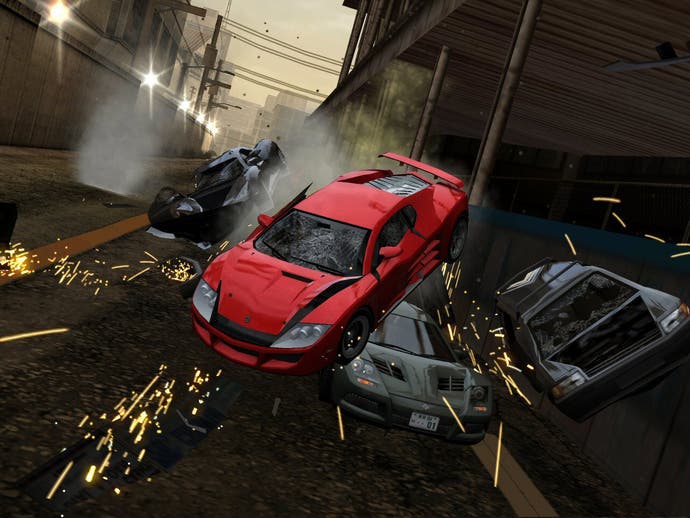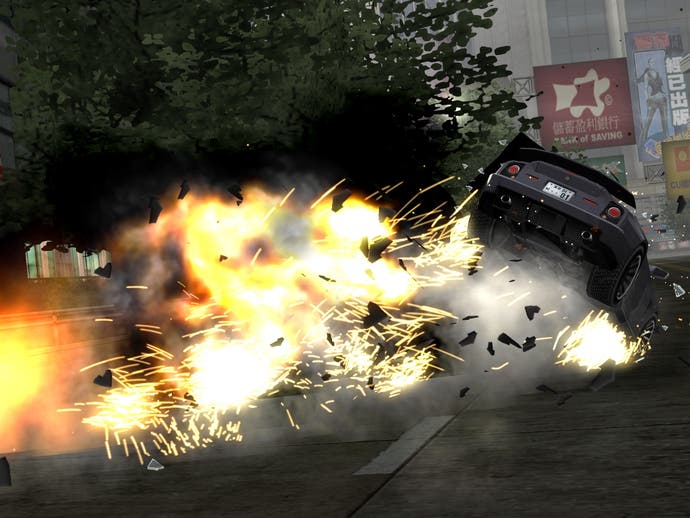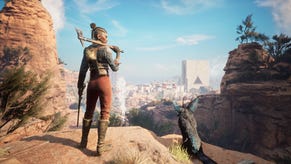Burnout Revenge
Less icons, more iconic?
Here's an email yours truly recently received from a friend-of-a-friend who is also a mother (altogether: aww), and sometimes asks about what she should buy for her son:
"Hiya. Cheers for the cosplay links [er, unrelated - Ed]. Now then, I try not to ask you too many questions about games, but he's on about another one now - something called Burnout Revenge. He wants to know when it's out, and I want to know whether I should buy it for him. Can you help?"
So, in order to kill two birds with one stone (just to clarify, that's a figure of speech; killing young mothers is wrong and you shouldn't do it), here is a response that served the reply-mail well enough, and gives you all an idea of what we make of Burnout Revenge:
"Hello! Burnout Revenge is out on PS2 and Xbox on September 16th. The Xbox one will probably look a whole lot sharper. As to whether you should buy it for him... We-he-heelll...
"Like the other three (he really should play 2 and 3 in particular if he hasn't already), it's about driving very fast and there are modes that involve racing hell-for-leather without hitting things, and others that involve racing just as fast with the express purpose of hitting things. Some modes treat car accidents as little pins to pop your excitement bubble, while others treat them as jackhammers to pound fun into your head. And, for as long as they avoid having people flying through the windscreen, there's no reason to think it's at all wrong or nasty; it's like a big car play set - except with pyrotechnics too. This one goes faster, looks prettier, and blurs the lines between those two modes. He'll like it, because everyone does.
"But, on the off-chance you're actually after a fairly detailed run-through of its individual features and improvements over Burnout 3, along with a degree of personal opinion based on the preview build of the game we've had in the office recently, let's continue, by way of a short history lesson!
"Burnout 2 - the series' first truly big success - was very black and white. Well, it was very bright-colour and other-bright-colour anyway. You could race around very fast and you got the benefit of a huge speed-boost for racing into oncoming traffic and destroying things, but the goal was to win races without crashing too much. The attendant Crash mode turned that idea on its head somewhat; faced with a particular traffic junction, you had to try and earn as many points as possible by picking a line to race into the junction and involving as many cars as possible in the ensuing pile-up.

"Burnout 3 took this and dressed it all up in sparkling threads. There were some issues with the interface and the way the online mode worked (at least to some eyes and routers), but it certainly gave people more of the same, which was arguably what they wanted. Everything was bigger, faster, and offered more obvious routes to its hidden depths. Burnout 2's Crash junctions, for example, could deliver high scores many millions of points in excess of what people saw when they first started playing, but you had to dig deep for them, experimenting endlessly even when you thought you'd done as well as possible. Burnout 3 introduced a great many more junctions, and threw in multipliers and other score-shifting icons to Crash mode, which allowed players to reap huge rewards relatively easily - but at the cost of tethering the player to a particular path through the junction. Stray too far and you couldn't get to the 4x multiplier, for example, which could defeat the point of any insane brilliance you were demonstrating through common methods elsewhere in the scenario - and you wanted to avoid the heartbreaker score-ruiner at all costs.
"In some senses, Burnout Revenge goes back to basics. Crash is a good place to start. Multipliers, heartbreakers - this sort of stuff is all gone. Instead you have to concentrate on starting at top speed using a golf-game-style swing-o-meter (tap once to start, once more to try and get a peak speed, and once more in the sweet spot to release the brakes at the best moment - dicing with the twin dangers of stalling or blowing the engine on the start) and then plough into traffic with greater freedom. This is better, at first glance, although there is one element that might divide - the need to try and hit a 'Target vehicle', which comes in from a particular place. Do this and you do much better. It is a bit like trying to get to a 4x multiplier, but it is the only thing to make a beeline for, so it feels like there are less waypoints to hit on the way through a junction; there is a goal, but you can choose your path. We like that.

"Of the various icons you could hit in Burnout 3's Crash mode, one idea that survives is 'Crash-breaker', but its use here is quite different - now it's something that your initial impact builds you up to. When a meter fills up thanks to all your destruction, you can hammer a button repeatedly to power-up the crash-breaker, which then causes a massive explosion that launches you into the air - at which point you're free to use another of Burnout 3's surviving ideas, Aftertouch, to direct your car's path as it comes down to land and hopefully make an impact on other vehicles.
"Crash mode isn't the only area that's seen attention. Racing still demands that you build up boost by dodging cars closely, racing into oncoming traffic and so on, but it also rewards you for clipping vehicles. Slamming into one will still cause you to crash (holding you up and potentially letting others past, even if you can use Aftertouch to steer your wreckage into their path) and ramming into rival racers to force them to crash still gives you 'Takedown' bonuses, but if you clip the back of a small car you no longer crash. Instead, the other car careens off in another direction. EA calls this 'checking' - hockey-style. Clipping something into a junction can create a huge pile-up - and doing it cleverly can be used to block the path of your rivals as they roar along behind you.

"There's a whole new mode to take advantage of this clipping too, called Traffic Attack. This is a bit demented. You basically have to cause damage by clipping - and each additional vehicle wrecked without wrecking yours will keep your timer alive. Complete a lap and your score multiplies, but you won't complete many if you don't clip cars into dodgy situations. It's a nice idea - and we look forward to seeing how it's developed.
"Other modes are Eliminator and Road Rage. Eliminator involves a six-man race where the last car is eliminated at intervals - thankfully over set periods of time and not just over laps, on this occasion - while Road Rage is about taking an old EA bike game and delivering it to the one chap on eBay who still gives a damn. Also (and without lying this time), it's about destroying as many computer-controlled cars as possible.
"Beyond that, there are the overarching changes. There's a new 'Revenge' meter (well, every EA game needs a good gimmick, right?), which is about pouring death and destruction upon those who cause you grief. For bonuses, of course. And there are locations 'inspired' by Detroit, Rome and Tokyo. There's online play, too - something we'll be investigating more in the near future. And there are the graphical updates.

"Now, Burnout 2 looked lovely. Very shiny, very colourful, kind of 'tech-demo-y' - but stylish in a way of its own. Burnout 3 was a bit grittier, with bigger explosions and greater levels of car deformation. Burnout Revenge continues along this logical path toward the next-generation of game graphics (some evidence of which we saw in a game called Full Auto on Xbox 360 at E3 this year; although we doubt that'll have anything to rival Burnout's smashing-Crashing ideas), with far more detailed textures, car designs and complex scenery (including lots of destructible environmental elements), and the level of deformation is great. There used to be trucks with logs stacked on top of them? The logs now fall off. Buses and lorries no longer crumple a bit; they act like concertinas being squelched by the flabby arms of well-fed buskers. And the explosions radiate warmth like a particularly sentimental Elton John track. Like that one about Tony Danza, to fall back on an old Friends joke.
"'Balance' is a word we'll be considering a great deal as we close in on Burnout Revenge's release date, of course, but the signs are good. 'Brown' is another one, judging by the palette - although we expect things to liven up a bit visually once we get out of the muddy old Detroit. But we'll definitely be taking a close interest in Burnout Revenge, because for all the pretenders there still isn't a whole lot else that comes close - and developer Criterion wants things to stay that way."
So anyway, yours truly sent that explanation off to his mothering chum, and this was the response:
"Ok, thanks."







.png?width=291&height=164&fit=crop&quality=80&format=jpg&auto=webp)


